[English] 日本語
 Yorodumi
Yorodumi- PDB-7kl1: Cocrystal structure of human CaMKII-alpha (CAMK2A)kinase domain a... -
+ Open data
Open data
- Basic information
Basic information
| Entry | Database: PDB / ID: 7kl1 | |||||||||
|---|---|---|---|---|---|---|---|---|---|---|
| Title | Cocrystal structure of human CaMKII-alpha (CAMK2A)kinase domain and GluN2B(S1303D) | |||||||||
 Components Components |
| |||||||||
 Keywords Keywords | TRANSFERASE / CaMKII / Kinase / Human / CAMK2A | |||||||||
| Function / homology |  Function and homology information Function and homology informationpeptidyl-threonine autophosphorylation / calcium- and calmodulin-dependent protein kinase complex / regulation of endocannabinoid signaling pathway / Ca2+/calmodulin-dependent protein kinase / excitatory chemical synaptic transmission / dendritic spine development / negative regulation of hydrolase activity / Activated NTRK2 signals through FYN / regulation of neurotransmitter secretion / Synaptic adhesion-like molecules ...peptidyl-threonine autophosphorylation / calcium- and calmodulin-dependent protein kinase complex / regulation of endocannabinoid signaling pathway / Ca2+/calmodulin-dependent protein kinase / excitatory chemical synaptic transmission / dendritic spine development / negative regulation of hydrolase activity / Activated NTRK2 signals through FYN / regulation of neurotransmitter secretion / Synaptic adhesion-like molecules / Trafficking of AMPA receptors / regulation of neuron migration / positive regulation of calcium ion transport / calcium/calmodulin-dependent protein kinase activity / negative regulation of dendritic spine maintenance / Assembly and cell surface presentation of NMDA receptors / regulation of monoatomic cation transmembrane transport / NMDA glutamate receptor activity / regulation of mitochondrial membrane permeability involved in apoptotic process / NMDA selective glutamate receptor complex / Neurexins and neuroligins / glutamate binding / glutamate receptor signaling pathway / CaMK IV-mediated phosphorylation of CREB / calcium ion transmembrane import into cytosol / protein heterotetramerization / glycine binding / Phase 0 - rapid depolarisation / monoatomic cation transmembrane transport / Negative regulation of NMDA receptor-mediated neuronal transmission / Unblocking of NMDA receptors, glutamate binding and activation / Ion transport by P-type ATPases / Long-term potentiation / Regulation of MECP2 expression and activity / regulation of neuronal synaptic plasticity / glutamate receptor binding / HSF1-dependent transactivation / positive regulation of excitatory postsynaptic potential / positive regulation of synaptic transmission, glutamatergic / positive regulation of cardiac muscle cell apoptotic process / regulation of protein localization to plasma membrane / cellular response to interferon-beta / MECP2 regulates neuronal receptors and channels / Ion homeostasis / glutamate-gated calcium ion channel activity / EPHB-mediated forward signaling / ligand-gated monoatomic ion channel activity involved in regulation of presynaptic membrane potential / ionotropic glutamate receptor signaling pathway / Ras activation upon Ca2+ influx through NMDA receptor / synaptic membrane / response to ischemia / angiotensin-activated signaling pathway / excitatory postsynaptic potential / positive regulation of receptor signaling pathway via JAK-STAT / transmitter-gated monoatomic ion channel activity involved in regulation of postsynaptic membrane potential / synaptic transmission, glutamatergic / RAF activation / G1/S transition of mitotic cell cycle / positive regulation of NF-kappaB transcription factor activity / brain development / postsynaptic density membrane / regulation of synaptic plasticity / cellular response to type II interferon / long-term synaptic potentiation / Interferon gamma signaling / Signaling by RAF1 mutants / Signaling by moderate kinase activity BRAF mutants / Paradoxical activation of RAF signaling by kinase inactive BRAF / Signaling downstream of RAS mutants / endocytic vesicle membrane / calcium ion transport / kinase activity / Signaling by BRAF and RAF1 fusions / late endosome / amyloid-beta binding / RAF/MAP kinase cascade / Ca2+ pathway / response to ethanol / chemical synaptic transmission / dendritic spine / postsynaptic membrane / learning or memory / cytoskeleton / calmodulin binding / protein phosphorylation / lysosome / neuron projection / postsynaptic density / protein serine kinase activity / protein serine/threonine kinase activity / dendrite / endoplasmic reticulum membrane / cell surface / protein homodimerization activity / mitochondrion / zinc ion binding / nucleoplasm / ATP binding / metal ion binding / identical protein binding Similarity search - Function | |||||||||
| Biological species |  Homo sapiens (human) Homo sapiens (human) | |||||||||
| Method |  X-RAY DIFFRACTION / X-RAY DIFFRACTION /  MOLECULAR REPLACEMENT / MOLECULAR REPLACEMENT /  molecular replacement / Resolution: 2.4 Å molecular replacement / Resolution: 2.4 Å | |||||||||
 Authors Authors | Ozden, C. / Stratton, M.M. / Garman, S.C. | |||||||||
| Funding support | 1items
| |||||||||
 Citation Citation |  Journal: Cell Rep / Year: 2022 Journal: Cell Rep / Year: 2022Title: CaMKII binds both substrates and activators at the active site. Authors: Ozden, C. / Sloutsky, R. / Mitsugi, T. / Santos, N. / Agnello, E. / Gaubitz, C. / Foster, J. / Lapinskas, E. / Esposito, E.A. / Saneyoshi, T. / Kelch, B.A. / Garman, S.C. / Hayashi, Y. / Stratton, M.M. | |||||||||
| History |
|
- Structure visualization
Structure visualization
| Structure viewer | Molecule:  Molmil Molmil Jmol/JSmol Jmol/JSmol |
|---|
- Downloads & links
Downloads & links
- Download
Download
| PDBx/mmCIF format |  7kl1.cif.gz 7kl1.cif.gz | 133.4 KB | Display |  PDBx/mmCIF format PDBx/mmCIF format |
|---|---|---|---|---|
| PDB format |  pdb7kl1.ent.gz pdb7kl1.ent.gz | 99.4 KB | Display |  PDB format PDB format |
| PDBx/mmJSON format |  7kl1.json.gz 7kl1.json.gz | Tree view |  PDBx/mmJSON format PDBx/mmJSON format | |
| Others |  Other downloads Other downloads |
-Validation report
| Summary document |  7kl1_validation.pdf.gz 7kl1_validation.pdf.gz | 1 MB | Display |  wwPDB validaton report wwPDB validaton report |
|---|---|---|---|---|
| Full document |  7kl1_full_validation.pdf.gz 7kl1_full_validation.pdf.gz | 1 MB | Display | |
| Data in XML |  7kl1_validation.xml.gz 7kl1_validation.xml.gz | 25.7 KB | Display | |
| Data in CIF |  7kl1_validation.cif.gz 7kl1_validation.cif.gz | 34.1 KB | Display | |
| Arichive directory |  https://data.pdbj.org/pub/pdb/validation_reports/kl/7kl1 https://data.pdbj.org/pub/pdb/validation_reports/kl/7kl1 ftp://data.pdbj.org/pub/pdb/validation_reports/kl/7kl1 ftp://data.pdbj.org/pub/pdb/validation_reports/kl/7kl1 | HTTPS FTP |
-Related structure data
| Related structure data | 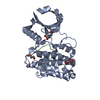 6x5gC 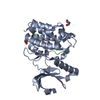 6x5qC 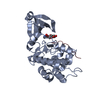 7kl0C 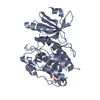 7uiqC 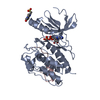 7uirC 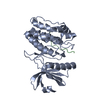 7uisC 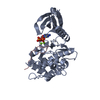 7ujpC 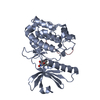 7ujqC 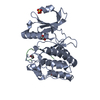 7ujrC 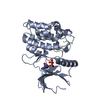 7ujsC 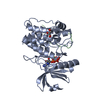 7ujtC 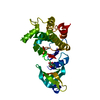 6vzkS C: citing same article ( S: Starting model for refinement |
|---|---|
| Similar structure data |
- Links
Links
- Assembly
Assembly
| Deposited unit | 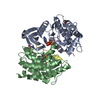
| ||||||||||||||||||
|---|---|---|---|---|---|---|---|---|---|---|---|---|---|---|---|---|---|---|---|
| 1 | 
| ||||||||||||||||||
| 2 | 
| ||||||||||||||||||
| Unit cell |
| ||||||||||||||||||
| Noncrystallographic symmetry (NCS) | NCS domain:
NCS domain segments: Component-ID: _ / Ens-ID: 1 / Beg auth comp-ID: THR / Beg label comp-ID: THR / End auth comp-ID: ARG / End label comp-ID: ARG / Refine code: _ / Auth seq-ID: 7 - 274 / Label seq-ID: 1 - 268
|
- Components
Components
-Protein / Protein/peptide , 2 types, 4 molecules ABCD
| #1: Protein | Mass: 30548.086 Da / Num. of mol.: 2 / Mutation: D135N, Q223K Source method: isolated from a genetically manipulated source Source: (gene. exp.)  Homo sapiens (human) / Gene: CAMK2A, CAMKA, KIAA0968 / Production host: Homo sapiens (human) / Gene: CAMK2A, CAMKA, KIAA0968 / Production host:  References: UniProt: Q9UQM7, Ca2+/calmodulin-dependent protein kinase #2: Protein/peptide | Mass: 2782.165 Da / Num. of mol.: 2 / Mutation: S1303D / Source method: obtained synthetically / Source: (synth.)  Homo sapiens (human) / References: UniProt: Q13224 Homo sapiens (human) / References: UniProt: Q13224 |
|---|
-Non-polymers , 4 types, 125 molecules 






| #3: Chemical | | #4: Chemical | #5: Chemical | #6: Water | ChemComp-HOH / | |
|---|
-Details
| Has ligand of interest | N |
|---|---|
| Has protein modification | N |
-Experimental details
-Experiment
| Experiment | Method:  X-RAY DIFFRACTION / Number of used crystals: 1 X-RAY DIFFRACTION / Number of used crystals: 1 |
|---|
- Sample preparation
Sample preparation
| Crystal | Density Matthews: 2.3 Å3/Da / Density % sol: 46.53 % |
|---|---|
| Crystal grow | Temperature: 277 K / Method: vapor diffusion, sitting drop / pH: 6.5 Details: 0.1M 1,3-bis(tris(hydroxymethyl)methylamino)propane, 0.1 M Ammonium sulfate, 20% PEG 6000, 19mM HECAMEG |
-Data collection
| Diffraction | Mean temperature: 100 K / Ambient temp details: 100 K thorughout the collection / Serial crystal experiment: N | |||||||||||||||||||||||||||||||||||||||||||||||||||||||||||||||||||||||||||||||||||||||||||||||||||||||||||||||||||||||||||||||||||||||||||||||||||||||||||||||||||||||||||||||||||||||||||||
|---|---|---|---|---|---|---|---|---|---|---|---|---|---|---|---|---|---|---|---|---|---|---|---|---|---|---|---|---|---|---|---|---|---|---|---|---|---|---|---|---|---|---|---|---|---|---|---|---|---|---|---|---|---|---|---|---|---|---|---|---|---|---|---|---|---|---|---|---|---|---|---|---|---|---|---|---|---|---|---|---|---|---|---|---|---|---|---|---|---|---|---|---|---|---|---|---|---|---|---|---|---|---|---|---|---|---|---|---|---|---|---|---|---|---|---|---|---|---|---|---|---|---|---|---|---|---|---|---|---|---|---|---|---|---|---|---|---|---|---|---|---|---|---|---|---|---|---|---|---|---|---|---|---|---|---|---|---|---|---|---|---|---|---|---|---|---|---|---|---|---|---|---|---|---|---|---|---|---|---|---|---|---|---|---|---|---|---|---|---|---|
| Diffraction source | Source:  ROTATING ANODE / Type: RIGAKU MICROMAX-007 HF / Wavelength: 1.5418 Å ROTATING ANODE / Type: RIGAKU MICROMAX-007 HF / Wavelength: 1.5418 Å | |||||||||||||||||||||||||||||||||||||||||||||||||||||||||||||||||||||||||||||||||||||||||||||||||||||||||||||||||||||||||||||||||||||||||||||||||||||||||||||||||||||||||||||||||||||||||||||
| Detector | Type: DECTRIS PILATUS3 R 200K-A / Detector: PIXEL / Date: Jun 25, 2019 / Details: Rigaku VariMax HF | |||||||||||||||||||||||||||||||||||||||||||||||||||||||||||||||||||||||||||||||||||||||||||||||||||||||||||||||||||||||||||||||||||||||||||||||||||||||||||||||||||||||||||||||||||||||||||||
| Radiation | Protocol: SINGLE WAVELENGTH / Monochromatic (M) / Laue (L): M / Scattering type: x-ray | |||||||||||||||||||||||||||||||||||||||||||||||||||||||||||||||||||||||||||||||||||||||||||||||||||||||||||||||||||||||||||||||||||||||||||||||||||||||||||||||||||||||||||||||||||||||||||||
| Radiation wavelength | Wavelength: 1.5418 Å / Relative weight: 1 | |||||||||||||||||||||||||||||||||||||||||||||||||||||||||||||||||||||||||||||||||||||||||||||||||||||||||||||||||||||||||||||||||||||||||||||||||||||||||||||||||||||||||||||||||||||||||||||
| Reflection | Resolution: 2.4→50 Å / Num. obs: 24724 / % possible obs: 99.9 % / Redundancy: 5.7 % / Rmerge(I) obs: 0.183 / Rpim(I) all: 0.083 / Rrim(I) all: 0.201 / Χ2: 2.569 / Net I/σ(I): 5.9 / Num. measured all: 141803 | |||||||||||||||||||||||||||||||||||||||||||||||||||||||||||||||||||||||||||||||||||||||||||||||||||||||||||||||||||||||||||||||||||||||||||||||||||||||||||||||||||||||||||||||||||||||||||||
| Reflection shell | Diffraction-ID: 1
|
-Phasing
| Phasing | Method:  molecular replacement molecular replacement |
|---|
- Processing
Processing
| Software |
| ||||||||||||||||||||||||||||||||||||||||||||||||||||||||||||
|---|---|---|---|---|---|---|---|---|---|---|---|---|---|---|---|---|---|---|---|---|---|---|---|---|---|---|---|---|---|---|---|---|---|---|---|---|---|---|---|---|---|---|---|---|---|---|---|---|---|---|---|---|---|---|---|---|---|---|---|---|---|
| Refinement | Method to determine structure:  MOLECULAR REPLACEMENT MOLECULAR REPLACEMENTStarting model: 6VZK Resolution: 2.4→48.5 Å / Cor.coef. Fo:Fc: 0.932 / Cor.coef. Fo:Fc free: 0.89 / SU B: 8.901 / SU ML: 0.203 / Cross valid method: THROUGHOUT / σ(F): 0 / ESU R: 0.508 / ESU R Free: 0.282 / Stereochemistry target values: MAXIMUM LIKELIHOOD Details: HYDROGENS HAVE BEEN ADDED IN THE RIDING POSITIONS U VALUES : REFINED INDIVIDUALLY
| ||||||||||||||||||||||||||||||||||||||||||||||||||||||||||||
| Solvent computation | Ion probe radii: 0.8 Å / Shrinkage radii: 0.8 Å / VDW probe radii: 1.2 Å / Solvent model: MASK | ||||||||||||||||||||||||||||||||||||||||||||||||||||||||||||
| Displacement parameters | Biso max: 100.31 Å2 / Biso mean: 25.653 Å2 / Biso min: 8.62 Å2
| ||||||||||||||||||||||||||||||||||||||||||||||||||||||||||||
| Refinement step | Cycle: final / Resolution: 2.4→48.5 Å
| ||||||||||||||||||||||||||||||||||||||||||||||||||||||||||||
| Refine LS restraints |
| ||||||||||||||||||||||||||||||||||||||||||||||||||||||||||||
| Refine LS restraints NCS | Ens-ID: 1 / Number: 8288 / Refine-ID: X-RAY DIFFRACTION / Type: interatomic distance / Rms dev position: 0.11 Å / Weight position: 0.05
| ||||||||||||||||||||||||||||||||||||||||||||||||||||||||||||
| LS refinement shell | Resolution: 2.4→2.46 Å / Rfactor Rfree error: 0
|
 Movie
Movie Controller
Controller


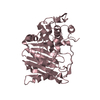
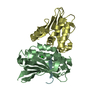
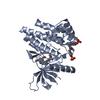
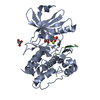

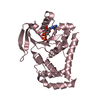

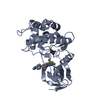
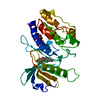

 PDBj
PDBj





















